 ATC
ATC
Cardiopulmonary Resuscitation (CPR)
Importance of CPR
Cardiopulmonary resuscitation (CPR) is a lifesaving technique. It aims to keep blood and oxygen flowing through the body when a person’s heart and breathing have stopped.CPR can be performed by any trained person. It involves external chest compressions and rescue breathing.CPR performed within the first six minutes of the heart stopping can keep someone alive until medical help arrives.
Although rescue breathing techniques were used to revive drowning victims as early as the 18th century, it wasn’t until 1960 that external cardiac massage was proven to be an effective revival technique. The American Heart Association (AHA) then developed a formal CPR program.
While there’s no substitute for formal CPR training taught by certified instructors, the AHA recently recommended that people who haven’t received CPR training initiate “hands-only” CPR. This method removes the rescue breathing and is easy to perform, proven to save lives, and better than waiting until trained help arrives.
Performing hands-only CPR
People without CPR training can perform hands-only CPR by following the steps below.
1. Survey the scene
Make sure it’s safe for you to reach the person in need of help.
2. Check the person for responsiveness
Shake their shoulder and ask loudly, “Are you OK?” For an infant, tap the bottom of the foot and check for a reaction.
3. If the person isn’t responsive, seek immediate help
Call 112 or your local emergency services if the person isn’t responsive. You can also ask someone else to call. If you’re alone and believe the person is a victim of drowning, or if the unresponsive person is a child from age 1 to 8, begin CPR first, perform it for two minutes, then call emergency services.
4. Check the heart with an automated external defibrillator (AED)
If you’re trained in CPR and come across someone who’s unresponsive or having difficulty breathing, follow the steps for hands-only CPR for 30 chest compressions.
Then perform the following actions:
1. Open the airway
Put the palm of your hand on the person’s forehead and tilt their head back. Gently lift their chin forward with your other hand.
For infants and children from age 1 to 8, a head tilt alone will often open their airway.

2. Give rescue breaths
Rescue breaths are appropriate for anyone age 1 and older. With the airway open, pinch the nostrils shut, and cover the person’s mouth with a CPR face mask to make a seal. For infants, cover both mouth and nose with the mask. If a mask isn’t available, cover the person’s mouth with yours.
Give two rescue breaths, each lasting about 1 second.
Watch for their chest to rise with each breath. If it doesn’t, reposition the face mask and try again.
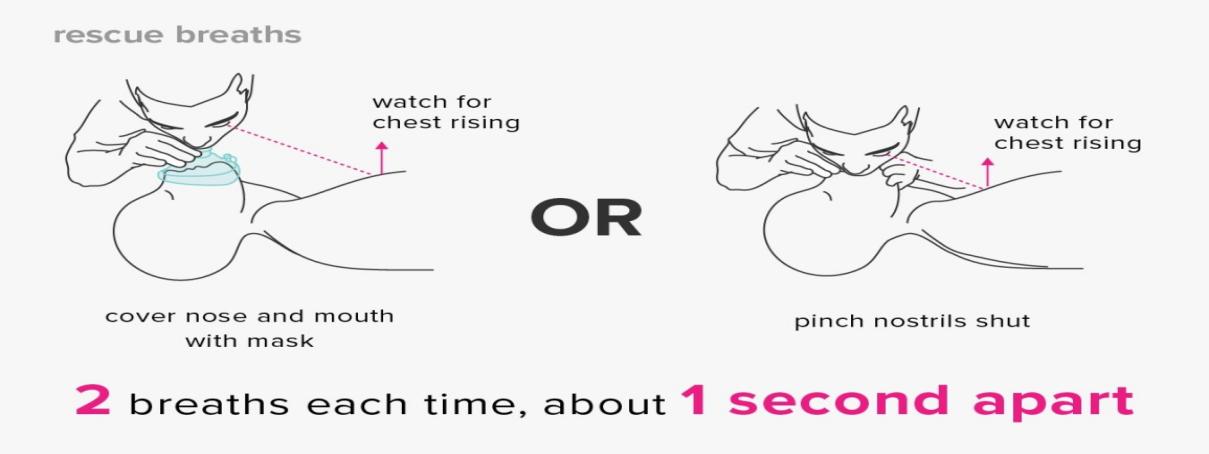
3. Alternate rescue breathing with chest compressions
Continue alternating 30 compressions with two rescue breaths until the person begins to breathe or until medical help arrives.
If the person begins to breathe, have him or her lie on their side quietly until medical assistance is on the scene.
Training for CPR and an Automated External Defibrillator (AED)
The automated external defibrillator (AED) can detect abnormalities in a person’s heart rhythm and, if needed, deliver an electric shock to the chest to restore normal rhythm to the heart. This is known as defibrillation.
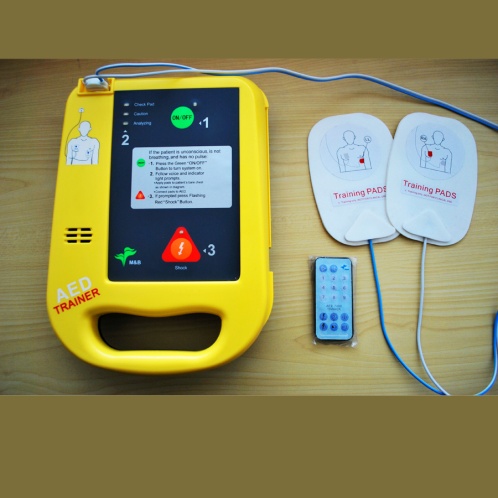
Sudden cardiac arrests are often caused by a fast and irregular heart rhythm that begins in the heart’s lower chambers, or ventricles. This is ventricular fibrillation. An AED can help restore the heart’s normal rhythm and even help revive a person whose heart has stopped functioning.
With training, an AED is easy to use. When used properly in conjunction with CPR, the device greatly increases a person’s chances for survival.
No mouth-to-mouth required in new CPR rules
You can skip the mouth-to-mouth breathing and just press on the chest to save a life.
In a major change, the American Heart Association recently said that hands-only CPR — rapid, deep presses on the victim’s chest until help arrives — works just as well as standard CPR for sudden cardiac arrest in adults.
Hands-only CPR calls for uninterrupted chest presses — 100 a minute — until paramedics take over or an automated external defibrillator is available to restore a normal heart rhythm.
This action should be taken only for adults who unexpectedly collapse, stop breathing and are unresponsive. The odds are that the person is having cardiac arrest — the heart suddenly stops — which can occur after a heart attack or be caused by other heart problems. In such a case, the victim still has ample air in the lungs and blood and compressions keep blood flowing to the brain, heart and other organs.
A child who collapses is more likely to primarily have breathing problems — and in that case, mouth-to-mouth breathing should be used. That also applies to adults who suffer lack of oxygen from a near-drowning, drug overdose, or carbon monoxide poisoning. In these cases, people need mouth-to-mouth to get air into their lungs and bloodstream.
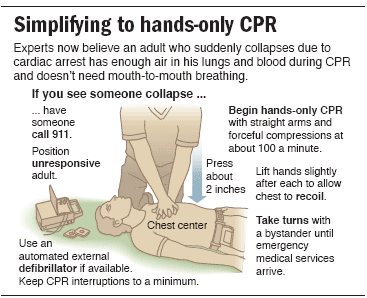
First Aid Tips
What would you do if you cut your finger while chopping vegetables? How would handle a stovetop burn, a spider bite, or a child’s scrape from a fall? Minor injuries happen every day, and most are easy to treat at home. But to handle them quickly and calmly, you need to know what to do and have the right supplies.
How do I make a first aid kit?
A well-stocked first aid kit is a must-have for treating minor injuries at home and on the go. You can buy a first aid kit or put one together on your own. Keep your supplies in a sturdy, clear plastic box so you can see what’s inside.
What should be in my first aid kit?
Adhesive tape
Alcohol wipes
Allergy medicine
Aloe vera gel
Antibiotic ointment
Bandages in different sizes
Calamine lotion
Cold packs
Elastic bandages
Gauze rolls and pads
Hand sanitizer (for your travel first aid kit)
Hydrocortisone cream
Latex-free gloves
Pain relievers like acetaminophen and ibuprofen
Saline wound wash
Scissors and tweezers
Where
should I store my first aid kit?
You don’t want to go searching for supplies when there’s a minor accident to tend to. Your kit should be easy to find. But it should be kept in a high, childproof cabinet, far away from kids’ prying fingers. Keep one full-sized kit in a central spot at home, such as your kitchen or bathroom. Then put a smaller kit in your car or purse for when you’re on the road.
How often should I check my first aid kit?
Items can run out if you use them often, and medicines can expire if you rarely need them, so go through everything in your kit, and replace any empty or out-of-date items at least once a year.
Cuts and Scrapes
How do I treat a minor cut or scrape?
Follow these steps to keep cuts clean and prevent infections and scars.
Wash your hands. First, wash up with soap and water so you don’t get bacteria into the cut and cause an infection. If you’re on the go, use hand sanitizer.
Stop the bleeding. Put pressure on the cut with a gauze pad or clean cloth. Keep the pressure on for a few minutes.
Clean the wound. Once you’ve stopped the bleeding, rinse the cut under cool running water or use a saline wound wash. Clean the area around the wound with soap and a wet washcloth. Don’t get soap in the cut, because it can irritate the skin. And don’t use hydrogen peroxide or iodine, which could irritate the cut.
Remove any dirt or debris. Use a pair of tweezers cleaned with alcohol to gently pick out any dirt, gravel, glass, or other material in the cut.
Do I need to bandage a cut or scrape?
You don’t need to bandage every cut and scrape. Some heal more quickly when left uncovered to stay dry. But if the cut is on a part of the body that might get dirty or rub against clothes, put on a bandage to protect it. Change the bandage every day or whenever it gets wet or dirty.
How long should a cut or scrape be covered?
Once a solid scab has formed, you can take off the bandage.
When do I need to call my doctor?
Check with your doctor or go to the emergency room if:
The cut is deep, long, or the edges are jagged. You may need stitches and a tetanus shot.
The cut or scrape is from a dirty or rusty object. You may need a tetanus shot.
The injury is from an animal or human bite.
You can’t stop the bleeding with direct pressure.
You can’t get dirt out of the wound.
The cut is on your face or near a joint, like on your fingers.
The skin around the cut gets red and swollen or develops red streaks.
Pus drains from the cut.
You have a fever of more than 100.4 F (in either an adult or child).
How do topical antibiotic ointments work?
Topical antibiotics are medicines you put on your skin to kill bacteria. Most cuts and scrapes will heal without ointment, but they can reduce scars and help the wound heal faster. If you do use an antibiotic ointment, apply it to your skin one to three times a day and then cover with a clean bandage.
When should I use gauze and tape?
Gauze and tape work best for large cuts and scrapes that bandages won’t cover. Ask your pharmacist which type of gauze is best for you.
How should I apply gauze and tape?
Wash your hands with soap and water. You can also wear gloves.
Gently wash the wound with a wet piece of gauze or washcloth.
Place a piece of clean gauze over the wound.
Apply tape around the edges of the gauze to hold it in place.
How do I prevent scars?
When your body heals after a cut, scrape, or burn, sometimes a scar can be left behind. Depending on the injury, some scars are small, and others are bigger and more noticeable.
To prevent scars, follow these tips:
Wear helmets, kneepads, and other protective gear to avoid injury.
Treat any cuts or other wounds right away.
Keep the wound moist (try an antibiotic ointment or petroleum jelly) while it heals.
Don’t pick at the scab.
Consider covering your cut with silicone gel sheeting, a clear, sticky pad that can speed healing.
If the scar isn’t fading, ask your doctor about creams or ointments to make it less obvious.
Nosebleeds
How do I treat a nosebleed?
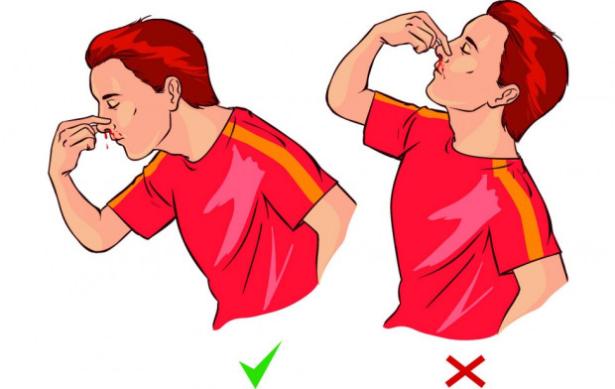
Nosebleeds usually look a lot worse than they are. Most of the time you can stop the flow with a few simple steps:
Lean the head slightly forward, so blood doesn’t run down the throat.
With a tissue or washcloth, gently press the nostrils together to stop the bleeding.
Hold the nose for at least 5 minutes. Then check to see if the bleeding has stopped. If it hasn’t stopped, gently squeeze for another 10 minutes.
Call the doctor or go to an emergency room if:
The bleeding hasn’t stopped after 15 to 20 minutes or keeps starting again.
The bleeding is fast and there’s a lot of blood.
The bleeding is from an injury to your nose or face.
You feel faint or weak.
Splinters
How do I remove a splinter?
Splinters are more of an annoyance than real health problem, but if you’ve got one stuck in a finger or toe, you’ll want to get it out. How you remove a splinter depends on how deep it is.
If the splinter is sticking out of the skin:
Wash the skin around the splinter with soap and water.
Clean a pair of tweezers with a cotton swab dipped in alcohol.
Grab the end of the splinter with the tweezers.
Pull it out at the same angle as the splinter went in.
Clean the skin again with soap and water.
If the splinter is under the skin:
Wash the skin around the splinter with soap and water.
Clean a needle and tweezers with alcohol.
Gently scrape away the skin above the splinter with the needle until you can see the top of the splinter.
Grab the end of the splinter with the tweezers and pull it out at the same angle it went in.
Clean the skin again with soap and water.
Animal Bites and Insect Stings
How do I treat animal bites and scratches?
Sometimes a seemingly friendly dog or cat can bite or scratch. If you or your child gets a bite, follow these steps to treat the wound:
Hold a towel or gauze to the area to stop the bleeding.
Clean the wound with soap and water.
Cover it with a clean bandage or gauze pad.
When should I see a doctor for an animal bite?
For any animal bite, you may need an antibiotic to prevent infection. So it’s always a good idea to call your doctor, especially if you have medical conditions that weaken your immune system. Also, you should call your doctor or head to the emergency room if:
The bite was caused by an animal you don’t know, or by any wild animal like a raccoon, skunk, or bat. You may need a tetanus or rabies vaccine.
The bite is large, or it doesn’t stop bleeding after you’ve held pressure on it for 15 minutes. It may need to be closed with stitches.
You think the bite may have damaged a bone, tendons, or nerves, because you can’t bend or straighten the body part or you’ve lost feeling in it.
The wound is red, swollen, or oozing fluid.
How do I treat bee, wasp, and other insect stings?
Here’s what to do:
If the insect has left behind a stinger, remove it from the skin so less of the venom gets into your body. You can scrape out the stinger with the edge of a credit card or the dull edge of a knife. Don’t squeeze the stinger. You might release more of the venom into your skin.
Once the stinger is out or if there is no stinger, wash the area around the sting with soap and water.
Hold an ice pack or cool washcloth to the sting to stop it from swelling.
Spread calamine lotion or baking soda mixed with water to relieve pain.
To prevent itching, use a spray or cream containing hydrocortisone or antihistamine.
How do I treat a mosquito bite?
Here’s what to do:
Apply firm pressure to the bite for 10 seconds to help stop the itch.
Use a baking soda paste or hydrocortisone cream 4 times a day to relieve itching. Don’t have either on hand? Holding ice or a wet washcloth on the bite will also help.
Take an antihistamine if the bite is very itchy.
What are the signs that my child is allergic to the insect?
It’s normal for the skin around the insect sting to swell up and get red. But call 112 or go to the emergency room if you see any of these signs of an allergic reaction:
Dizziness
Hives -- red, itchy bumps on the skin
Stomach cramps, vomiting, or diarrhea
Swelling of the tongue
Trouble breathing, wheezing
Anyone who has allergies to bees, wasps, or other stinging insects should keep an epinephrine auto-injector at home, work, and school in case of a sting.
Minor Burns
What are the different types of burns?
Grabbing a hot pot or splashing boiling water on your skin are just two common causes of burns around the house. When you get a burn, first check to see which type it is. Some are more serious than others.
First-degree burns are painful but minor. They turn red and may swell.
Second-degree burns form blisters. The skin may be very red and painful.
Third-degree burns make the skin look white or charred. The burns may not hurt because nerves have been damaged.
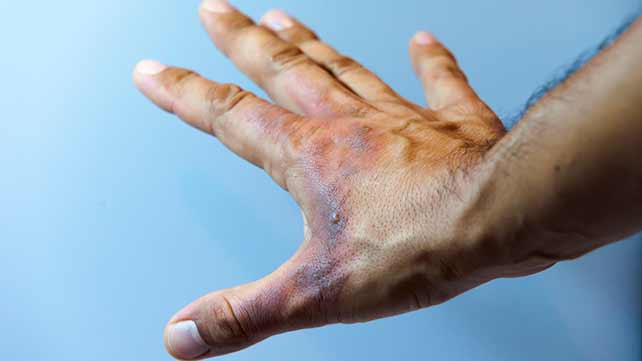
When should I see a doctor?
Serious burns need to be treated by a doctor or in a hospital. Call for medical help if:
You have a third-degree burn.
The burn is larger than 2 to 3 inches.
The burn is on your face, hands, feet, or over a joint like your shoulder or knee.
The burn goes all the way around a hand, arm, foot, or leg.
The pain gets worse instead of better.
The burn was caused by electricity or a chemical.
You see fluid or pus oozing from the burn.Top of Form
How do I treat burns?
You can treat minor first-degree burns and small second-degree burns at home. Here’s what to do:
Place the burned area under running cool water for at least 5 minutes to reduce swelling.
Apply an antiseptic spray, antibiotic ointment, or aloe vera cream to soothe the area.
Loosely wrap a gauze bandage around the burn.
To relieve pain, take acetaminophen, ibuprofen, or naproxen.
Never put butter on a burn or pop any blisters that form. You could damage the skin and cause an infection.
Sprains and Strains
What’s the difference between a sprain and strain?
Sprains and strains are common injuries. Here’s how to tell the difference:
A sprain is a stretch or tear of a ligament, the tough tissue that connects bones and supports the joints. You’re most likely to get a sprain in the wrist or ankle. Sprains cause pain, bruising, and swelling. You may have trouble moving the joint.
A strain is an injury to a muscle or tendon, the thick tissue that attaches muscles to bones. You’re most likely to get a strain in your back or hamstring muscles. Strains cause pain, weakness, swelling, and muscle cramps. You may have trouble moving the muscle.
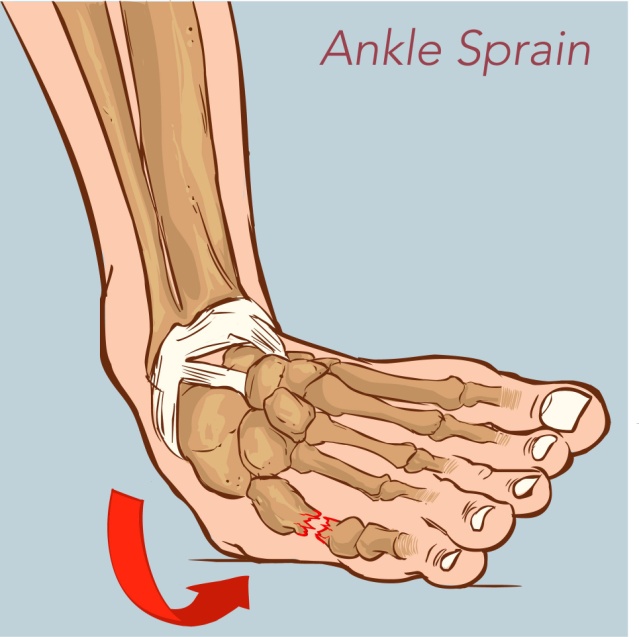
How do I treat sprains and strains?
For a mild sprain or strain:
Rest the limb to give it a chance to heal.
Hold ice on the area for 20 minutes at a time, four to eight times a day, to bring down swelling. Don’t use heat -- it could make the area swell even more.
Wrap an elastic bandage or splint around the sprain or strain.
Put a pillow under the injured body part to keep it raised.
Take over-the-counter medicines such as ibuprofen to relieve the pain.
For a more severe sprain or strain, where there’s a lot of pain, swelling, and you have trouble moving around, see your doctor. You may need crutches or physical therapy.
First Aid for Epilepsy Seizures
There isn't much you can do to stop a seizure once it starts. But you can help protect someone from harm during one. Some seizures are more dangerous than others, but most aren't an emergency. If you want to do something for the person, focus on keeping them safe.
What Seizures Look Like
These seizures follow a pattern:
The person seems to "check out." They won't answer if you talk to them. They won't react if you wave a hand in their face or shake them. They may collapse.
Their muscles clench and they become as rigid as a board. (This is the tonic phase. It lasts a few seconds.)
Next comes a series of jerking movements. (This is the clonic phase. It can last a few seconds or several minutes.)
Eventually, the jerking stops and they're alert and can talk again, but they may be dazed or unsteady for a little while.
Any generalized seizure can be dangerous because the person is unaware of their surroundings and can't protect themselves from harm. The uncontrolled thrashing raises their chances of getting hurt.
Focal seizures are different. They're less intense and usually last no more than a minute or two.
Part of their body, like an arm, might get stiff or go floppy. You may see repeated, rhythmic, or jerking movements in one place or that spread to different body parts. The person could zone out or stare at nothing. They may or may not realize what's happening but can't control it. When it's over, they won't remember a thing.
What You Can Do
It's all about taking precautions. For someone having a generalized tonic-clonic seizure:
Give them room. Keep other people back.
Clear hard or sharp objects, like glasses and furniture, away.
Cushion their head.
Loosen clothing around their neck, if you can safely.
Don't try to hold them down or stop their movements.
Don't put anything in their mouth. Contrary to popular myth, you can't swallow your tongue during a seizure. But putting something in their mouth could damage their teeth, or they might bite you. If their head isn't moving, turn it to one side.
Look at your watch at the start of the seizure, so you can time its length. Remember, this probably isn't an emergency, although it may look like one.
After the jerking stops, gently place them on their side, to help keep their airway clear.
For milder seizures, like a bit of staring or shaking arms or legs, guide the person away from hazards, including traffic, stairs, and water.
Don't leave someone who's had a seizure alone. Stay until they're fully aware of where they are and can respond normally when you talk to them. Speak calmly. Reassure them and explain what they missed if they're confused or frightened. Don't give them anything to drink or eat until they've completely recovered.
When to Call an Emergency Number
It's a child's first seizure.
The seizure lasts longer than 5 minutes.
Another seizure begins soon after the first.
The person doesn't "wake up" after the movements have stopped.
The person was injured during the seizure.
